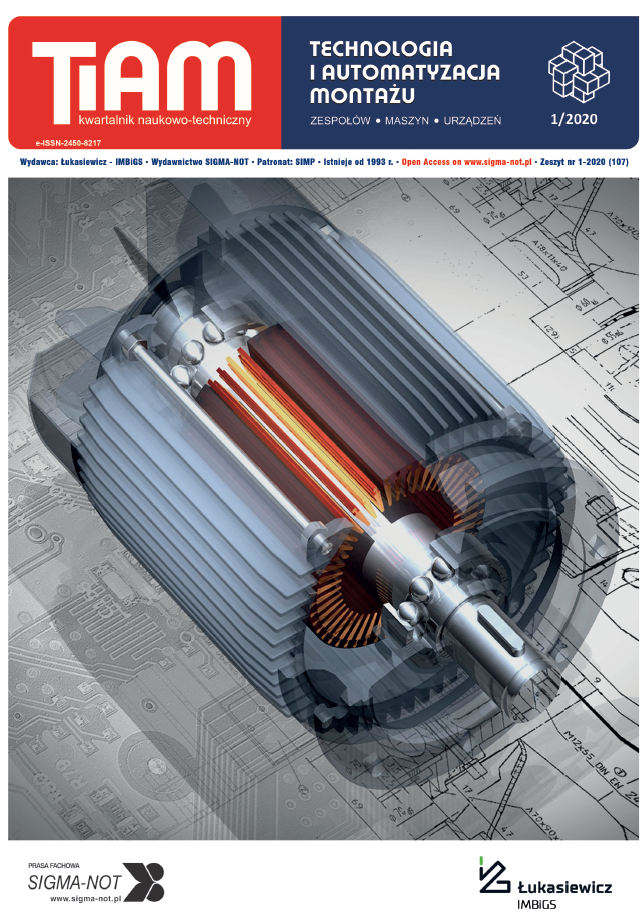Abstract
In the paper, the results of the comparative studies of the surface roughness, as obtained after face milling, with the application of standard cutting inserts and Wiper inserts, have been discussed. The presented results of the studies show in what technological conditions it is possible to obtain the best effects of reducing the surface roughness.
This is an Open Access article distributed under the terms of the Creative Commons Attribution License CC BY 4.0 (https://creativecommons.org/licenses/by/4.0/)
References
Abouelatta O. B., Madi J. 2001. „Surface roughness prediction based on cutting parameters and tool vi-bration in turning operations”. Journal of Materials Processing Technology 118: 269-277.
Astakhov V. P., Shvets S. 2004. „The Assessment of plastic deformation in metal cutting”. Journal of Materials Processing Technology 146(02): 193-202.
Childs T. H. C., Sekiya K., Tezuka R., Yamane Y., Dornfeld D., Lee D. E., Min S. and Wright P. K. 2008. „Surface finishes from turning and facing with round nosed tools”. Annals of CIRP 57(1): 89-92.
Fedai Y. et. al. 2018. „Optimization of machining pa¬rameters in face milling using multi-objective Taguchi technique”. Technical Journal 12: 104-18.
Greń J. 1987. „Statystyka matematyczna podręcznik programowany”. Warszawa: PWN.
Jarosz K., Löschner P. 2018. „The effect of changes in depth of cut on surface roughness in machining of AISI 316 stainless steel”. Journal of Machine Engi¬neering 18(1): 72-79.
Kadirgama K. et al. 2008. „Optimization of Surface Roughness in End Milling on Mould Aluminium Alloys (AA6061-T6) Using Response Surface Method and Radian Basis Function Network”. JJMIE 2(4): 209- 124.
Kłonica M. 2017. „Wykorzystanie elementów sta¬tystyki w procesie badawczym na przykładzie po¬miarów wybranych parametrów chropowatości po¬wierzchni”. W Innowacje w zarządzaniu inżynierii produkcji, 772-782, tom I. Opole: Oficyna Wydawni¬cza Polskiego Towarzystwa Zarządzania Produkcją.
Mayur N. et. al. 2017. „Optimization of CNC Face Milling Process Parameters for Inconel 718 by Using Taguchi Method – A Review”. IRJET 04: 806-810.
Mitsubishi, face mills. Available from: http://www. mhuk-carbide.co.uk/technical_information/tec_ro-tating_tools/face_mills/tec_milling_guide/tec_mil¬ling_precautions/tec_milling_precautions_asx445 [Accessed: 02/12/2019].
Mitsubishi, face mills. Available from: http:// www.mitsubishicarbide.net/mhg/pl/face_mil-ls/20000020/20066004 [Accessed: 02/12/2019].
Mitsubishi, face mills. Available from: http:// w w w.mi t s u b i s h i c a r b i d e . c o m / a p p l i c a t i o n / f i¬les/9014/4643/8968/b034g-f.pdf [Accessed: 02/12/2019].
Mourão A. et. al. 2010. „The effect of wiper edge in¬serts on the specific cutting energy in face milling of aluminium alloys”. International Journal of Modern Manufacturing Technologies II(2): 71-75.
Reddy M. R., Kumar P. R., Mohana Rao G. K. 2011. „Effect of feed rate on the generation of surface ro-ughness in turning”, International Journal of Engine¬ering Science and Technology 3(11): 8099-8105.
Toledo J. V. R. et. al. 2018. „Performance of wiper geometry carbide tools in face milling of AISI 1045 steel”. Journal of the Brazilian Society of Mechanical Sciences and Engineering 40: 478.
Zalewski K., Matuszak J. 2017. „Badania porównaw¬cze wpływu parametrów technologicznych frezowa¬nia wybranych stopów tytanu na moment skrawania i chropowatość obrobionej powierzchni”. RUTMech XXXIV(89) (4/17): 563-572.


